What to do with dahlias for the winter. Storage options tubers. Waxing dahlia tubers for winter storage
Flowers - this is perhaps the most wonderful gift of nature to mankind. They have so much charm and grace! Each type of flower is beautiful in its own way. But dahlia deserves special attention. She is considered to be the queen of autumn flowers. How can it be properly stored to enjoy its unsurpassed beauty again and again? Let's figure it out. With the onset of autumn cold dahlia need to dig. When to do this depends on weather conditions and terrain. In one region, frosts occur in October, in the other in November, or even in December. Nature itself will give you the main signal for action. Such a frost signal.
Dig dahlias after the first frost. It is best to do this when the flower itself is “stuck” by frost, and the leaves turn black.
It is better to have time to do it within the specified period, since warming usually occurs in the fall after the frost. In this case, the buds will begin to grow, and the dahlia will weaken considerably. Then, although the flower perezimuet in a secluded place, but will be much weaker.
If, instead of warming, frost intensifies, it may simply die.
Is it possible not to dig for the winter
Do not dig dahlia completely impossible. In our latitudes, no winter is complete without severe frosts. Such a climate not suitable for flowers, and they simply die.
Digging instructions
This question is very important, since it depends on him whether the flower will remain at all.
The optimal distance from the flower when digging - 25cm
The dahlia root system is fragile, and if you accidentally damage it, while digging, the flower will disappear completely. Start digging at a distance of 25 cm from the flower. Stem pre-cut, at a distance of 15 cm from the root collar.
Categorically it is forbidden to pull heavily undermined flower. Strong shake it to clear from the ground too. It is best to leave it to dry in the sun so that the ground on the tuber dries out and it is easier to clean it. Be careful not to damage the neck at the base. If this happens - it can rot.

Next stage - thorough inspection of tubers, since only absolutely healthy ones are laid for wintering. To do this, inspect each separately. If you find rusty, brown spots, cut them out without regret, otherwise the entire tuber will rot. Cut out only clean tools that can be ignited on fire, in quality sterilization.
To carefully check all the tubers, use the advice: after inspection, after all processing tools, should put them in the water.
Those that surfaced, throw out without regret, they still do not overwinter.
After careful selection, proceed to their processing. For this, omit the tubers in solution of potassium permanganate, or other fungicide, for 20-30 minutes. Then leave them to dry in the sun for another 30-40 minutes. And then we give them to rest in a room for 10 days, in order for the wounds to heal, after cutting the spoiled particles, and for the tubers to harden properly.
How to store
Storage is carried out in a well ventilated area. The temperature in it should be + 3 + 7 degrees. Humidity: 60-80% .
There are different ways to store tubers:
- In the box. Fold them in a box, one layer and pour dry sand. Before this, dry with dry ash.
- Embalm with paraffin. Melt the paraffin wax, dip it in each. Store in the basement. Zaparafineny tubers, saved 100%, as they are not subject to rotting and drying out.
- In any capacity layers, sprinkled with coniferous sawdust. The needles allocate fungicides of the disinfecting action that also interfere with rotting and drying.
- In the package in the refrigerator. To do this, the tubers are wrapped in coconut fiber, pre-moistened, placed in a bag, and stored until spring on the bottom shelf of the refrigerator. Only in the package it is necessary to make punctures for ventilation.
- In parchment bags. Poured sawdust.
- In food film. Just wrapping her tubers.
- In ordinary bags. A newspaper is laid on the bottom, tubers are laid, they are poured with large sawdust, or vermiculite, covered with a newspaper on top (newspapers retain moisture levels). Tie the bag and pack it in a plastic bag, do not tie the bag (to keep access of oxygen).
No matter what method of storage you use, tubers be sure to periodically check. And if you still find the elements of rottenness, be sure to throw away the infected, to avoid further infection of the healthy.
In antiquity, Aztec tribes used dahlia tubers and stems used as reservoirs for water.
Keep the flowers right, and they will delight your eyes with regal beauty and grandeur.
Perhaps the most time consuming part of caring for dahlias is storage of dahlia tubers in winter. Without knowing, when digging dahliasHow to prepare them for storage and under what conditions dahlias should winter, you cannot get good planting material. Tubers simply "mummified."
Therefore, today we will talk about how to prepare dahlias for the winter and how to store them.
How and when to dig dahlias
The formation of dahlia tubers begins in spring, but their full formation is completed by the end of the season. And the better the tubers ripen, the better they will be.
The first frosts - those that sometimes happen in August or September - harm the flowers, a little - the leaves, but do not pose any danger to the tubers. Therefore digging dahlia in autumn should be carried out before severe frosts - around October. There is a lot of envy on the quality of the soil and climatic conditions.
Before you start harvesting dahlia, mercilessly clean your flowerbed: remove all weak, bad-flowering plants, as well as sick or damaged by pests. Last desirable to burn with a lump of earth.
Dahlias in the fall, a couple of days before digging out the tubers, can be cut off, leaving “penechki” about 5 cm long. Some growers do this so that the apical buds can nakleut - this makes cutting easier. But there are opponents of this method. Their argument is that water entering a cut wound leads to decay and opens entry for viruses. Scientists have not yet refuted and confirmed these conjectures, therefore, to trim or not to trim dahlias for the winter before digging - your decision.
![]()
Before digging dahlias in the fall, the bush should be dug on all sides with a pitchfork or a spade 25-30 cm from the stem. Thanks to this, the tubers will not be hurt, and the long dahlia roots will be cut. The excavated tuber is turned upside down to dry, then rinsed with a stream from a hose to remove the remnants of the earth (many microorganisms are stored in the ground that serve as pathogens).
Drying the tubers for several hours is also needed for the fragile neck of the tuber to dry and become less brittle.
How to divide dahlia tubers
It is possible to divide dahlia tubers into delenki both in spring and in autumn. In the autumn it is easier to do, until the tubers are not too harsh. But in the spring, buds on delenki will be more clearly marked, and the division of the tuber will be more correct. This is important for novice florists.
And yet most people for dahlia fall division - in the fall and time is more, and it is easier to handle delenki than whole tubers.
Do not forget to leave a little plant necks with buds, so that in the spring dahlias sprouted. But all the suction roots must be removed - because of them rotting tubers can begin. Small, too hard or fragile tubers can not be divided.

When dividing dahlias, try to do so that one delenka was one kidney. But if you have little experience, just divide the tuber into four parts.
After you divide the tubers into delenki, they should be processed. It is better to give preference to an aqueous solution of a fungicide of systemic action, and some gardeners add and. Each delenka need to be kept in a solution for about 15 minutes.
By the way, if you notice that a dahlia tuber doesn’t sink when diving into a solution, safely throw it away: it will definitely not last until planting.
Treated tubers are laid out on a wooden surface or cardboard for drying (about a day).
In order not to confuse varieties of dahlia tubers, mark them with a marker, chemical pencil or attach labels.
How to store dahlias
The most important factors in keeping dahlia are maintaining the correct temperature and humidity, otherwise the delenki will wither and die. The temperature should fluctuate within 0- + 10 degrees, ideal - + 3- + 5 degrees. For these purposes, suitable garages, cellars, etc.
How to store dahlias? There are several common ways. Here they are:
- storing dahlias with vermiculite. Dahlias in the winter will be perfectly preserved if you store them in containers with vermiculite. It is better to take large factions, since small ones can harm the human lungs. To do this, take the bag or box, put vermiculite on the bottom, then put the dahlia tubers, then vermiculite again, and so on. At the same time, the volume of the used substance and tubers should be approximately the same. Let's clarify that vermiculite has a drawback: it perfectly retains moisture, but if the temperature suddenly rises, the dahlia tubers can begin to germinate.
![]()
- storage of dahlias with sand, sawdust, peat, "dead land". In this case, you need to take a large capacity and fill the tubers with the selected material so that there are no voids. If you live in a region with a dry climate, it is better to slightly wet the insulating material. Dahlias in winter will remain good, but sprouts begin to hatch earlier than in the case of vermiculite.
- paraffin storage of dahlias. This is a laborious way, but there are varieties of dahlias that begin to “wake up” in December. For such cases, and should be applied waxing. To do this, dip the delenka in paraffin heated to 70-80 degrees. After that, dahlias can be stored in a regular box in a cool place.
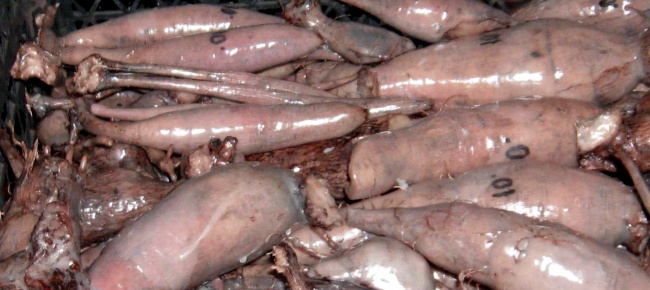
- storing dahlias with a clay shell. To do this, prepared delenki descend into a clay mash, which has the consistency of sour cream. This crust is removed easily - you only need to knock a little on it, and the delenka is ready for planting.
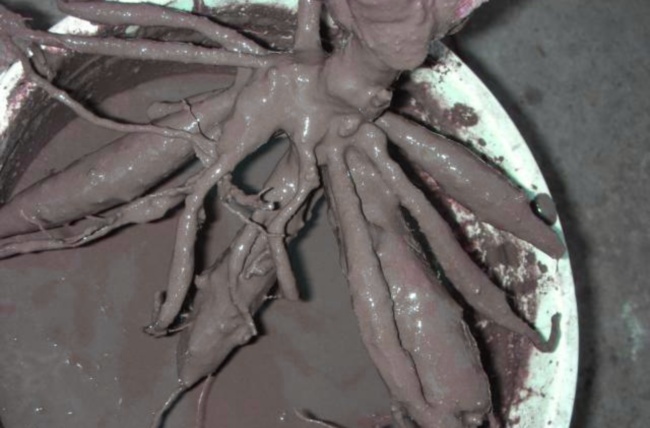
Remember - if you use wooden or cardboard boxes for storage - be sure to overlay the container with several layers of newspapers, since wood takes up valuable tuber moisture. If you decide to use simple plastic bags, make holes in them so that the plants do not suffocate.
The main thing in dahlia storage in winter is to maintain a constant temperature (without hesitation) and humidity. And do not forget once a month to inspect dahlias, removing tubers with the slightest sign of damage to rot.
And now we offer you a video on how to dig and store dahlias in the winter. Enjoy watching!
Tatyana Kuzmenko, member of the editorial board Sobkor of the Internet publication "AtmAgro. Agroindustrial Gazette"
Even seasoned gardeners do not always manage to keep dahlia tubers in winter. What to say about novice amateurs who have just started planting these wonderful flowers in their country house, but have already managed to get used to them and love them.
It is already autumn in the yard, it's time to dig up the tubers and remove them for storage, and here at once there are so many questions:
- When to dig dahlias for the winter?
- How to dig up the tubers?
- How to prepare dahlia tubers for winter storage?
- Where and how best to store dahlias?
We will now answer all these questions.
When digging dahlias in the fall
First of all, do not rush to dig dahlias. Only well-ripened tubers will survive the winter safely. Although the tubers begin to form as early as spring, they finally mature in the fall. Therefore, let them sit in the ground as long as possible, because under any storage they will not feel better than in the ground. And that would not worry that a sudden frost can grab the tubers - just spud them.
The signal for digging is the first severe frost, after which the plants take on such a deplorable appearance that it immediately becomes clear that it is time to dig up these dahlias!

If after frost the dahlias acquired such a deplorable appearance - it is time to dig them up
After frost, dahlias must be dug out within 2 to 3 days for two reasons:
- Frozen leaves and stems are likely to start to rot, and this rot can go to the tubers.
- If it becomes warm again after the frost, then the growth buds on the root neck can wake up, but this is not necessary at the moment (for the same reason, you should not cut the dahlia stems in advance).
Of course, all these recommendations should not be taken as strict, binding instructions. Currently, you can get a fairly accurate weather forecast for several days. If, according to such a forecast, frost is expected only in three to four days, and it’s time for you to leave home, then do not hesitate to start digging dahlias and preparing them for winter storage. A few days in this case will not play a big role.
Watch the video clip when and how to dig dahlias:
Before you start digging tubers, you need to take care of the tags with the name of the variety and color. Some do otherwise, the tubers are laid out in different boxes and signed boxes. In the spring, all these inscriptions will serve you well.
Many are interested in the question: is it possible to dig dahlias in wet weather or even in the rain? Yes you can. The work is certainly not very pleasant, but if there is no other time, you will have to dig in the rain.
Start by cutting the stem at a height of about 30 - 40 cm and remove everything that will get in the way. Dig a bush from all sides, trying not to damage the tubers and podzdev with a shovel or pitchfork deeper under the tubers, turn them out of the ground. Tubers are not located deep in the ground and it will not be difficult to do all this.

Dug up dahlia tubers.
Resist the temptation to shake and pull out the tubers, holding the barrel. The root neck is extremely fragile and just as important for the life of dahlias. It is very easy to break it; therefore, during digging, try not to take the barrel at all.
Having dug a bush, gently clean it from the ground, do not try hard, better then wash it with water from a hose. Put the cleaned tubers in the shade and start digging up the remaining bushes.
Having dug up all the tubers in this way, rinse them with a hose and proceed to the stripping.
- Secateurs cut all the roots, which are many there and they are completely unnecessary.
- All small nodules, dangling processes are also subject to rejection. There should be only full tubers attached to the root of the neck and having renewed buds.
- At the very end, cut the trunk very short, it is he who begins to rot first. Therefore, the shorter it is cut, the better, you can even scrape off the green soft tissue.
- Prepared shrubs fold to dry up tubers somewhere on the veranda, under a canopy.
An interesting way to store dahlia videos:
How to store dahlias
After the rhizomes are dug out, trimmed and washed, it is necessary to decide how they will be stored. Store the tubers either entirely or immediately divide them into delenki. Experienced growers often choose the second option, so that there would be less work in the spring.
Maybe not everyone knows, but dahlia tubers, in the form in which they were dug in the fall, are not planted in the spring. They must be divided into parts - delenki.
It is possible to share both in spring and in autumn, but if this is your first wintering, then it is better to postpone this occupation until spring. Whole, not divided tubers are stored all the same better delenok, besides, in the spring the buds already start to grow and it will be much easier for you to understand how many parts to divide them.
Preparation of dahlias for storage
Before laying for winter storage, the tubers are treated with baseol (30 g. Per bucket of water) or a dark red solution of potassium permanganate. In both solutions, the tubers are kept for 20 - 30 minutes, such treatment destroys all pathogenic pathogens, which are many in the soil. Some gardeners get a little easier and simply spray dahlia tubers with one of these solutions.
When storing dahlias in a room with not high humidity, the tubers can completely dry. Whatever happens, they can be dipped into a clay mash, resulting in a clay crust, which quite effectively prevents the evaporation of moisture. This talker should be liquid and resemble shop sour cream.
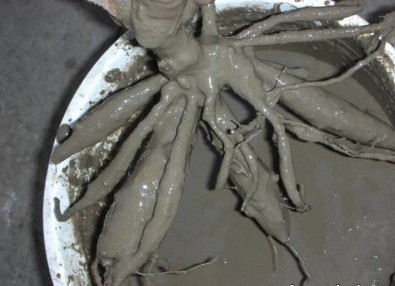
Bathing tubers in clay mash.
After bathing in a clay talker root - the tubers must be thoroughly dried for two to three days and only then sent to the cellar, where they are stored directly on the floor. Such a simple, popular way has proven itself very well.
Where to store dahlias
Each gardener always has his own experience and therefore tips on storing dahlias can be very different. But the basic rules always remain the same: the tubers should be stored in the dark, at a temperature of about 5 degrees and a humidity of 80 - 85%.
If the temperature does not even fall below 0 for a long time, the tubers will die, if it is high, the buds will begin to germinate in the middle of winter.
Sometimes you can hear conversations that it is enough to bury the tubers deeper into the ground and they spend the winter on the street. Do not listen to these people, quite a few such experiments were conducted and they all ended in failure.
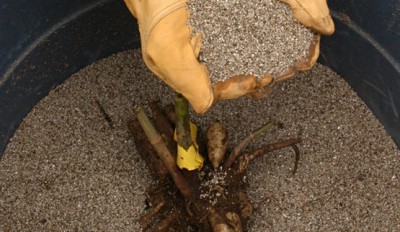
Storing dahlias in the sand.
Storage of dahlias in the cellar
The easiest way to keep the dahlia tubers in the basement or cellar, in which the temperature ranges from +1 to +8 degrees, and the humidity of 80%. If you have such a cellar, then the problem of wintering dahlias is practically solved for you. In such conditions, the tubers can be stored without additional shelters. Simply put them in boxes, crates or mesh bags that sell onions and potatoes and put them on the shelves in the cellar.
During the winter, especially closer to spring, inspect and discard the rotted nodules, otherwise the rot may spread to the neighboring delenki.
How to store dahlias in the pantry
In the absence of a cellar, you can try to keep the tubers in some sort of utility room, where the conditions for wintering are not ideal, but not room, for example in a cold storeroom, subfield, and so on. In this case, the tubers must be poured with sand, sawdust, or simply ground. In winter, go there and check how wintering takes place, you may have to dry the tubers if it is too wet or sprinkle with water if they start to dry out.
How to store dahlias in the apartment
Dahlia tuber storage in the refrigerator Video:
Many flower growers have neither a cellar nor a cold storeroom and successfully store dahlia tubers in a city apartment. For such storage, it is desirable to divide the tubers immediately into delenki, so they take up less space.
Another very important point. If dahlias overwinter in the cellar, then immediately after digging, slightly dried, you can bring them into the cellar. When wintering in an apartment, they must be kept for two to three weeks in a cold, damp room. This is done so that the tubers have a rough skin, then they will be stored much better.
There are many options for storing dahlias in the apartment, but the optimal one is likely to do this: lay out delenki in plastic bags, fill it with sawdust (you can use sphagnum dry moss) and DO NOT seal it tightly, and even better make holes in the package. Packages should be put in shoe boxes; they will be there in the dark.
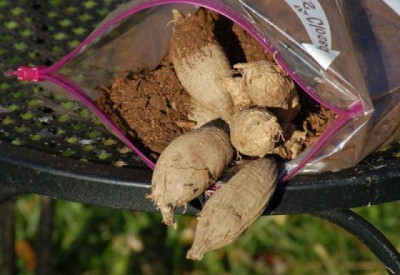
It is more convenient to keep dahlias in an apartment in such bags.
Now it remains to find the coldest place in the apartment. The choice here is not big, if you exclude the refrigerator, then there is space by the window or a balcony door. On the window sill behind the curtain is a good place, some store bags in the toilet, by the cold water pipe. The presence of a warmed loggia greatly simplifies the matter.
We can not say about another way of storing dahlias in the apartment - it is waxing tubers. At first glance, the occupation is difficult and expensive, but it is not quite so.
You do not need a bucket of paraffin, enough, and two - three candles. This is done like this:
- In a container in which the tubers fit, pour the water there and throw candles.
- Heat the water until the paraffin melts, then immediately turn off the fire. Neither of which boiling water is out of the question, otherwise the kidneys will die immediately.
- Quickly put a delenka into the pan and immediately reach for it. A paraffin film floating on top of the water envelops the tuber and it turns out to be in a thin, protective shell.
I must honestly say that waxing of tubers does not guarantee anything, but the chances of success increase significantly.
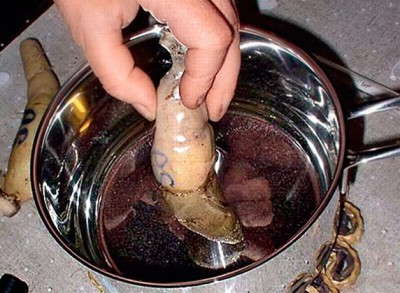
This is how the dahlia tubers are waxed.
What factors affect the safety of tubers
Growing dahlias for many years, gardeners have made some conclusions
- If dahlias grow in the shade, then their strawberries are small and worse stored.
- Old tubers hibernate badly, constant updating is required.
- Strawberries in overfed dahlias are also poorly preserved in winter.
- Poorly grown tubers grown in acidic soils.
- Tubers of different varieties (especially new ones) are not stored equally.
Tips experienced florist. O. Kormilitsina shares her dahlia storage experience.
The safety of tubers is largely dependent on how they are dug. In September, I root up or sprinkle a layer of compost on the root zone of my pets. I do this so that the frosts, which even in our country can happen already at the beginning of autumn, do not harm the roots.
I start digging dahlias after the sub-zero temperatures ruin the buds, flowers, and leaves. I prune the stems to 15–20 cm so that when digging there is no temptation to pull them. In no case can this be done: the root collar can be damaged, which will adversely affect the safety of dahlias in winter.
When digging it is very important not to cut the tubers with a shovel. The more powerful the shrub, the more susceptible, the larger and larger the nest, the farther from the center of the shrub I begin to dig in the plant. Then, deeply sticking a shovel, pushing it to the center of the root ball and dig it. I shake the ground with my hands, shorten the stalks so that no more than 7-10 cm remains to the root collar.
I attach a tag with the name of the variety to each nest. Then carefully rinse the tubers with water, soak the maxims (2 ml per liter of water) in the preparation solution for half an hour and place them somewhere in a well-ventilated place to dry.
Laying the hemp is not up, but down to cut the stems of glass water. The root neck after such a simple procedure does not rot. All this must be done for the best preservation of dahlias in the winter.
After 2-3 days of staying in the fresh air, I keep tubers in a country house for another week. Then I lay them in one layer in boxes and I fall asleep with high-moor peat so that only a little bit to cover the root neck.
Peat buy in the store. It is more economical than restoring a collection of beloved plants that died during the winter in spring. In the spring I use peat for mulching perennials.
Boxes descend to the basement and put on wooden boards. In winter, I check the moisture content of peat, which are covered with tubers. If it dries out, I spray it with water from a spray bottle.
Peat should be only slightly wet.!
I tried to keep the tubers in sawdust, but they often have to moisten.
The optimal storage temperature for dahlias is +3 + 5 degrees. Naturally, there is no such temperature in the basement all the time, but, nevertheless, the nodules are well preserved. There is little waste.
All our readers will be interested to know how you save your dahlias in the winter. Write about your experience (both successful and not successful) in the comments.
Other useful dahlia articles
- On this page you can get acquainted with the most different types of dahlias. There are small ones (which can be planted in pots or on the balcony), but there are big ones and simply huge ones.
- Detailed recommendations on the choice of location, planting dates, preparation of tubers, growing seedlings and much more.
- The most effective methods of pest control and treatment of diseases of your flowers.
- . Annual dahlias can be grown from seed. They will bloom all summer, will cost you much cheaper and you can change varieties every year.
Preserving the grown crop of dahlia tubers until spring is a big question for many gardeners. After all, each has its own conditions, possible for storage, and who has none at all. The easiest and most common way is to place the tubers after digging into a cellar or basement. In early spring, the tubers begin to germinate, and they are taken to the light. With this method, very often there are surprises, when either tubers are removed from the storehouse or are completely rotted, or completely dried. Therefore, every year flower growers experience many other, more reliable ways, and each one chooses for himself the only one that suits him.
Proper storage of dahlias.
For good preservation of the tubers, they must be dug in time so that they are fully ripe and not damaged by frost. When digging, the most important thing is to keep the buds that are on the top of the tubers, at the base of the stem, whole. In autumn, the buds can be small, almost imperceptible. The lower parts of a tuber injured when digging, trimmed with a shovel, should not be regretted. They still do not have buds, and when laying for storage, anyway, the tubers will be cut off.
➡ Many flower growers keep tubers whole, undivided. If they are planted in the spring, whole, then they will form bad roots and new tubers.
It is more difficult to divide woody tubers after storage in the spring than in the fall. Therefore, they are divided immediately when digging. On each part there should be a part of the root collar with dormant buds and at least one nodule from below, in order to feed these buds in the future. Extra roots and old tuber are cut off. All rotten parts are cut out, if they exist, suspicious red or brown spots, harbingers of diseases, and nodules with voids inside. Also completely removed the rest of the stem, to the kidneys. It is from it, usually with excessive moisture begins tuft rot. Wounds can be treated with green.
After trimming the diseased parts, the cutting tool must be disinfected with alcohol or over fire. If all parts are healthy, no tool handling is required.
Klubnevochki washed, preferably under low pressure from a hose, helping to remove pieces of earth with a brush. Then the tubers are soaked in a strong solution of potassium permanganate or another fungicide (foundation, max). Pop-up nodules can be thrown out, they will not be able to survive until spring, they will dry out. Sections are powdered with ash or powdered phytosporin. The washed and processed parts are laid out for drying. The thinner the spine, the less time it dries, from 2 to 4 hours to a day, so that the wounds heal slightly and heal. Varieties are marked with plastic or metal tags, and you can sign them directly on the nodules with a special stable marker or ballpoint pen.
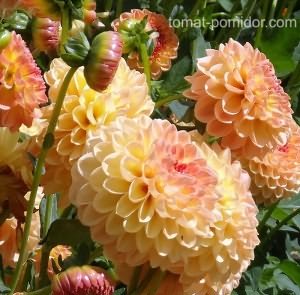
Conditions and temperature.
Then the tubers are stored. To do this, you need a cool room, with a temperature of 3-7 * C, an average of 5 * C, constant, without jumps, with a humidity of about 60%. It could be a basement, a cellar, a warmed balcony, a cool corridor.
Tubers are poured with some material to maintain constant moisture in them. It can be sand, large sawdust, peat, vermiculite, needles, moss-sphagnum. The main thing - that they were DRY. You can put each tubercle in a bag or a cut-off plastic bottle, sprinkling a thin layer on one of the above materials. You can put the tubers in wooden boxes or plastic baskets, zastilaya and sheltering newspapers. During storage, it is desirable not to allow individual nodules to contact each other, in order to avoid contamination. It is not recommended to store dahlias in the vicinity of potatoes.
In winter, it is periodically necessary to check the humidity, temperature and condition of the tubers. Drying can be sprinkled with water, and rot and dry. By the beginning of March or from an unexpected increase in temperature, dahlias can sprout, then they are brought into an apartment or a greenhouse, and grown as seedlings so that they bloom earlier.
Often, to save a valuable variety, cutting is used. Spring cuttings take root much easier than autumn ones. Sometimes it happens that some (especially often it happens with very exotic) varieties did not have a tuber over the summer. Then, in the fall, the excavated part of the stem with the roots is planted in a pot and put on the window sill, growing before planting in the spring in open ground.
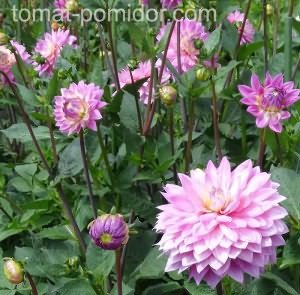
Some flower growers before storage dip the tubers in a clay mash to protect the tubers from drying out. This is especially true for thin tubers - strings, for example, non-terry varieties. Waxing is also practiced when the nodule is dipped into melted (but not boiling) paraffin on the hotplate, then quickly dipped into water to cool rapidly. The nodules treated in this way can be stored at a higher temperature, but they are harder to remove from dormancy.
Recently, the method of storing dahlias in polyethylene film has become increasingly popular. Divided into small pieces, washed and processed tubers are tightly wrapped with film, leaving no air gaps. No holes. Storage at the required 5 * C is excellent, but only if there are no random temperature fluctuations, otherwise when it rises, condensate will appear that can destroy the stored material. The method is convenient because the tubers take up little space, they can be stored even on the bottom shelf of the refrigerator, when checking the tubers their condition is clearly visible, and they do not touch each other.
How to store dahlia tubers in the winter
Dahlias decorate the gardens with their bright and lush flowers in summer and autumn. Therefore, many gardeners are trying to preserve the grown crop of dahlia tubers until spring. Some have difficulty storing rhizomes in winter. After all, further quality of plants depends on properly prepared winter storage.
When digging up dahlia tubers
As soon as the first autumn frosts began, and the leaves of the flowers began to die, you can begin digging the tubers. If you tighten with it, then strong frosts can destroy the leaves and stems. As a result, they will begin to die and rot. As a result, rotten stems will spread to the roots.
Tubers must be kept from beautiful and large bushes. Rhizomes of weak and thin bushes will not take root. In order to avoid breaking it, the flower stalks must be broken off or cut off before digging.
When trimming the stems, leave hemp sizes of 20-30 cm. This is done for convenience as well as not to damage the root neck. Then the bush gently undermine the shovel. Even if the tubers were damaged during the digging, you should not get upset, they will still be shortened.
Next, dig out a bush shake off the ground and rinse with water. Excess shoots from tubers can be cut with scissors. Tubers should be shortened by about 15 cm. If possible, process the tubers with a solution of fungicide. After that, the rhizome can be divided.
Stems cut almost to the base of the tubers. Each separated tuber must have buds present. If the tubers are very hard and have underdeveloped buds, then you can leave them entirely.
They can be used for grafting. Each office should be inspected for damage and signs of disease. If there are dark brown or rust stains, they must be removed.
At the initial stage of infection, you can notice a white coating on the tubers. If nothing is done, the tuber will infect other planting materials and will not survive until spring.
Before putting into storage, it is advisable to leave the roots of a flower for 10 days in a room with a low but positive temperature. This is done to prevent the skin from sticking and the healing of superficial wounds on tubers.
Dahlia tuber storage methods
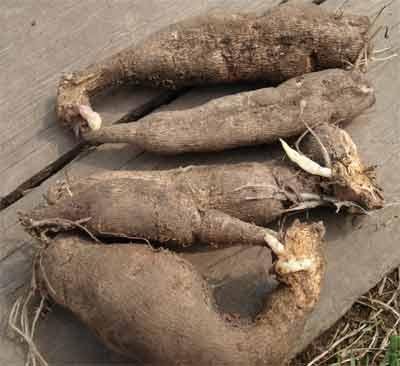
In order for dahlia tubers to successfully winter, they need to create all the necessary conditions. Before placing the tubers in boxes or containers, leave them to dry for a while.
Store tubers can be on the shelves. This method is quite simple and it can be used by novice gardeners. Add sand to the shelves and place the prepared dahlia tubers. They must first be put in boxes and poured with any materials.
After that, put the rhizomes in the prepared bags. They are filled with a special mixture - vermiculite, which is intended for storage. It is important to tie the bags well.
In addition to vermiculite, experienced gardeners use moss for storage. Planting material is wrapped in moss and laid out in packages. However, as a material for wintering it is used with caution. Dry moss pulls moisture from the plant, and wet moss can lead to decay.
To maintain constant humidity, it is necessary to pour tubers with sand, sawdust, peat, needles, etc. You can cover it with a newspaper, put it in plastic or wooden boxes. Cover the bottom of the box with any paper, and old newspapers will do. You can use plastic wrap.
From above fill up the dry earth with a thin layer. Then put the tubers and sprinkle with earth. On the same technology to lay the next row of tubers. Do not allow the tubers to come into contact with each other, as this may lead to infection. After that, cover the box and put it in the basement or cellar.
Another way to store rhizomes with the use of clay talkers. This method helps protect the tubers from drying out. It is prepared as follows: pour red water over ordinary clay so that the consistency resembles sour cream.
In a clay solution add copper sulphate and potassium permanganate in the same quantity and mix well. Lumps should not be. Each tuber is dipped in a cooked talker, taken out and left to dry. Then put in the bags and put in the box according to the above technology.
The third method of storing tubers is made using paraffin. Waxing procedure is quite time-consuming. To do this, you need paraffin, which can be purchased at the pharmacy or paraffin candles. It should be heated to a temperature of 70-80 degrees.
Heat candles in a water bath to obtain a liquid mass. Drain tuber from all sides. As a result, the rhizome should be completely covered with a layer of paraffin. Leave them cool. This procedure should be performed with each tuber.
After that, each grade individually wrap film, pack in paper or box. In the spring paraffin is removed and the tubers are prepared for planting.
The method of waxing protects the tubers from the adverse effects of external factors. This method is usually used for early varieties that are beginning to germinate in December or January.
Storage conditions for dahlia tubers

Store tubers should be at a temperature not higher than 7-10 degrees. Humidity in the room should be about 70-80%. A basement, a balcony and other places that meet these criteria will be suitable for storage.
Boxes with tubers can not be placed near the heating devices and drafts.
In winter, you must regularly monitor the tubers, check the humidity and temperature. Festering places should be cut, and then covered with coal and dried in the air. After that, lay back.
In case of excessive moisture, the bags should be opened and left for ventilation.
Paper or newspapers should be put in cardboard and wooden boxes. This will prevent the lack of moisture. If you use plastic bags, then it is necessary to make holes in them.
Dahlia tubers should only be stored in a cool place. If it is a balcony, then before the onset of frost, rhizomes should be removed to another location. It is not recommended to store rhizomes of dahlia together with potatoes.
Make sure that the planting material does not dry out and does not freeze. If the tubers shrink and shrivel, then periodically moisturize them. In the spring rhizomes are transferred to a warm place. Increased temperature contributes to the awakening of the kidneys.
Knowledge of all the subtleties in storing dahlia tubers in winter will allow you to admire the lush bloom all summer.
Useful video about proper care for dahlia tubers in winter:
OgorodSadovod.com
Cares gardeners: storing dahlias at home
To store dahlias at home was successful, you need to know how to dig them up and prepare for winter. Dig them before the frost, pre-affixing a label indicating the type, color, etc.

First you need to free the plant from props, garters. Then, remove the soil and trim the stem a little shorter than the hilling level. Now, stepping back from the remaining 20–25 cm stem, it is necessary to dig a trench deep in the bayonet of the shovel and carefully pry the tubers of the plant. For the stem can not pull in order to avoid damage to the root processes. They are very fragile.
The dug out roots, lightly shaken off the ground, are transferred to a room with an air temperature of 0 to 8 degrees and a humidity of 75-85% (you can put a basin with water next to it). In two weeks, the processes of nutrient distribution and preparation for a state of rest will be completed in the tubers. Before putting the dahlias in storage for the winter, you need to remove the ground from them, inspect them well, remove small and old, broken and diseased roots. They cut all unnecessary with a sharp knife, which is constantly dipped in a solution of manganese. Sections are powdered with ashes or smeared with dark raspberry manganese.
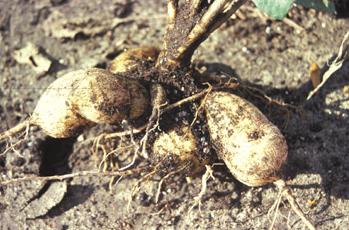
Storage of dahlias at home occurs in boxes or boxes. Tubers are laid in one layer and covered with sand or peat. Then sent to a room with the same temperature as when storing potatoes (from +1 to +7 degrees) and humidity of 60-70%. It can be a basement, cellar, underground floor, heated garage. In the refrigerator are the same conditions. Therefore, storage of dahlias in the apartment is quite possible. What is needed for this?
The main task is the preservation of growth buds, root cervix and tubers. If dahlias are supposed to be stored at home in a refrigerator, then a bunch of tubers are washed, disinfected for 30 minutes with raspberry manganese and dried for a day. Then put the roots in boxes or plastic bags and pour dry moss, shavings, etc. Tara is left open for access of air. In the absence of ventilation on the roots may appear mold or rot. Storing dahlias at home implies periodic inspections of planting material. If rot is detected, it is cut out, the cut is smeared with green paint, the filling material is changed. The mold is washed off with potassium permanganate, the tuber is ventilated.
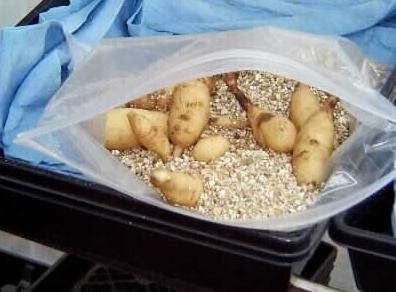
Small tubers can be simply wrapped in paper, put in a bag and, without closing, placed in a refrigerator or between balcony (window) frames. Of course, subject to appropriate temperature and inaccessibility of direct sunlight.
During winter storage, dahlias can deteriorate for several reasons: thickened planting, excessive fertilizing with nitrogenous fertilizers (manure, urea, etc.), the absence of autumn hilling. If the summer was rainy or the autumn was warm with a sharp cooling, then the dahlia's roots do not ripen, that is, they do not accumulate enough nutrients. And without them, they can not move the state of rest.
But flower growers in such cases do not despair. In the spring, they carefully examine the almost ruined tuber. If at least one surviving bud with a small nodule is found, it means that the plant will bloom even this year - the variety is preserved.
fb.ru
How to store dahlias in winter, roots, tubers, bulbs, when planting dahlias
Pompon dahlias
Dahlias are considered noble and beautiful flowers. They bloom almost until the end of autumn. and from this article you will learn how to store dahlias in the winter, their roots and tubers. The variety of shades of their colors is simply amazing. Each dahlia flower is simply unique, gorgeous and versatile. It is worth noting that dahlias are easy to care for and durability. Dahlia flowers tolerate almost any bad weather. Watering may not be regular, and the soil is not very good. However, dahlias do not like many gardeners lovers. Many prefer other colors. The main reason for this attitude to these plants lies in the fact that their tubers are very difficult to maintain in winter. You can save the tubers, dahlia bulbs for the winter, if you know a few secrets.
One of the main secrets for answering the question of how to properly store dahlias in winter is that dahlias must be properly prepared for digging, as well as properly planted, in which the plant tubers remain whole and intact.
How to dig dahlia tubers
In order not to harm the dahlia tubers, it is necessary to know exactly how and when it is better to dig the dahlia tubers. Only if certain rules are followed can dahlia tubers be preserved so that next year they can sprout.
Most gardeners are not advised to dig dahlias before the first frost. However, in this situation there is a risk that the tubers will freeze slightly and as a result they will just eat rot. That is why you should not wait for frosts. It is better to dig up dahlia bulbs a few weeks before the onset of cold weather. To determine this, just look at the weather forecast before. Before digging up the roots, the stems should be cut near the plant, leaving a small stump: about 10 centimeters from the tubers.
Dig dahlia tubers should be very careful not to damage the roots. To save the tubers, it is worth grabbing more land when digging. From the roots it is better to retreat by 25 centimeters. After digging, the tubers should be dried slightly in the sun. Do not wash the dahlias roots with water. This will complicate the drying step. You should not keep the tubers of those plants that had an unhealthy appearance. The last step in the preparation should be cleaning the tubers from the roots and the ground. Everything should be done carefully and without haste.
Dahlia storage
So, how to store dahlia tubers in the winter so that they do not die. It is not necessary to postpone the processing of tubers for a long time. Better to do everything in a couple of days. This is due to the fact that the tubers very quickly deteriorate and dry up. Today there are a huge number of methods that allow to save the dahlia tubers before the next planting.
Dahlia tuber storage
The easiest method is to store dahlia tubers in wooden boxes. Pre-tubers must be well dried, and the boxes covered with a newspaper. Boxes with dahlias should be placed in a cool room. It may be a garage or a shed. Here tubers should be stored no more than a week. After that, the boxes should be covered with a newspaper and placed in the basement or in the place where the vegetables are stored.
If you do not have a basement, then a method that allows you to store tubers of flowers in an apartment will suit you. To save the dahlia tubers you will need nets or boxes, candles or paraffin. On medium heat, make a water bath and melt paraffin on it. In melted paraffin should dip tubers from two sides. This must be done fairly quickly, as the paraffin hardens very quickly. Treated tubers should be neatly folded in separate boxes, pre-spreading them in varieties. After that boxes with dahlias can be placed on the balcony or in the pantry. The place where there will be boxes with tubers should be not raw, but cool.
This method allows you to save the dahlia tubers and protect them from rotting or drying out. If you do not have too many roots, you can resort to the following method of storing them. Clean the dahlia roots well. Put them on a newspaper in a cool place. Leave them to dry for several weeks. After the tubers have dried, it is necessary to remove the stems right down to the roots. Then put the dahlias in prepared containers. After that, dry sawdust or sand should be poured into the boxes. Bulk material should completely cover the tubers of flowers.
Chrysanthemum dahlia
A more convenient and economical method of storing dahlia roots is to use plastic bags or films. First of all, the tubers should be treated with colloidal sulfur or another solution intended for this purpose. In order to preserve dahlia bulbs in winter, it is necessary to put peat into the bags and place the plant tuber in it. After that, the bag should be tightly tied. All bags are stored in storage containers and placed in a dry and cool place. This method has a major advantage: the tubers will not contact each other. In addition, the state of the dahlia roots can be easily checked. After all, they will be in transparent bags.
To save a greater number of tubers, you must use a few tricks. Before processing the tubers of flowers can be divided into several parts. In this case it is necessary to select larger tubers with healthy buds. This will allow you to significantly increase the number of colors in the future. In addition, it will insure against the risk of losing all tubers. It is important to regularly check all dahlias and remove them from the box. This will prevent damage to the rest of the tubers. If you bought a dahlia in a store, then you should carefully examine it for the presence of kidney buds before sending it to storage in a box. If the buds do not hatch, then it is worth putting dahlia to germinate.
When to plant dahlias
After the winter has successfully survived by tubers, it is time to plant them. And so when planting dahlias, in the middle of spring one should select poorly choked dahlias from germinated ones. The first must be planted in the boxes with the ground, so they sprouted. And the latter continue to wait for landing. It is worth noting that poorly sprouted tubers should be left in the ground until the landing. Do not forget about their regular watering. All tubers in mid-May can be planted on a separate section prepared in advance.
Spherical Dahlia
so , how and when to plant dahlias so as not to harm them. The whole process of planting is quite simple and includes the following steps:
Digging holes, a depth of about 15 centimeters. Some water is poured into them and then fertilizer is added, which is intended specifically for dahlias. Sprouted tuber is laid out in the center of the excavated fossa. After this, the hole is covered with soil and poured over with water.
In order for dahlias to start well after the winter and begin to germinate more quickly, they need to create a small greenhouse. For this fit plastic cups or bottles of mineral water or juice.
As you see, growing dahlias is not that difficult. The main thing is to keep them and give the plants a little attention.

